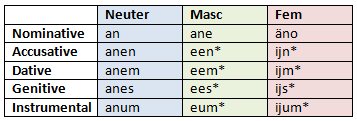Piscean language: Difference between revisions
No edit summary |
No edit summary |
||
| Line 27: | Line 27: | ||
Those words highlighted with an asterisk follow irregular patterns. 'Een', 'eem', 'ees' and 'eum' are contracted forms of 'aneen', 'aneem', 'anees' and 'aneum', respectively. Regarding the feminine irregularities, 'änoen', 'änoem', 'änoes' and 'änoum' first contracted to 'oen', 'oem', 'oes' and 'oum', but - for even easier pronunciation - the O (and E, where applicable) finally collapsed into the dipthong IJ, which sounds like the English word 'eye'. | Those words highlighted with an asterisk follow irregular patterns. 'Een', 'eem', 'ees' and 'eum' are contracted forms of 'aneen', 'aneem', 'anees' and 'aneum', respectively. Regarding the feminine irregularities, 'änoen', 'änoem', 'änoes' and 'änoum' first contracted to 'oen', 'oem', 'oes' and 'oum', but - for even easier pronunciation - the O (and E, where applicable) finally collapsed into the dipthong IJ, which sounds like the English word 'eye'. | ||
==Cases== | |||
Piscean implements five cases: nominative, accusative, dative, genitive and instrumental. Anderson affirms that these have greatly important and stylistic purposes. | |||
Firstly, they allow for flexible sentence structure that can place emphasis on a certain word by changing its location, yet retaining original meaning. For example: | |||
Se Hund bit sen Mann - The dog bites the man | |||
Sen Mann bit se Hund - The dog bites the man | |||
Both of the above Piscean sentences have the same translation into English. On first glance, an English speaker might confuse the second example as 'the man bites the dog', although this is because the object comes before the subject. Because the word 'Mann' is preceded by the accusative article and 'Hund', by the nominative, those skilled in Piscean can easily deduce the sentence's meaning. Meanwhile, the first example places emphasis on the subject, while the second places emphasis on the object. | |||
Revision as of 08:56, 24 July 2007
Piscean (Piscean: pisceesum) is the official language of the New Piscean Workers' Nation, founded on the manmade island New Pisces - off the coast of western France - that was created in 2028. Despite being the constructed language of Representative S.C. Anderson, Piscean is linguistically derived from Old English and Modern German; however, it is written not with the Latin or runic alphabets, but with the 'pro-Phoenician' Andersonic writing system devised in 2007. (For the purpose of this article, examples of Piscean will be transliterated into the Latin alphabet.)
Articles
The Piscean language includes three 'logical' grammatical genders. While in many languages, the genders do not often relate to physical properties of nouns, they do in Piscean; therefore, most nouns are neuter, while creatures of the male sex are masculine and creatures of female sex are feminine. If one refers to a creature, but does not wish to distinguish sex, the neuter gender can be used as a substitute. Observe the following examples:
- teet Sunne - the sun (no sex, so neuter)
- teet Mann - the person (no sex specified, so neuter)
- se Mann - the man (male, so masculine)
- seo Mann - the woman (female, so feminine)
The above example shows the importance the article plays in Piscean of distinguishing between sexes in a language where one noun fits all.
Definite article
The definite article is inflected in various ways, firstly split into three depending on grammatical gender, then into six depending also on quantity - whether singular or plural - and finally into a further thirty depending on grammatical case - whether nominative, accusative, dative, genitive or instrumental.
Those words highlighted with an asterisk follow irregular patterns. 'Enum' is a contraction arising from a rather complex - and now incorrect - 'teemenum'. 'Seäm' is a result of 'seoum', which is difficult for a Piscean speaker to pronounce. The O and U thus collapse into Ä. Similarly, 'som' is contrived, as 'säum' is awkward in speech, giving way instead to a collapse of Ä and U into O.
Indefinite article
The indefinite article (in English, 'a/an') is inflected in much the same way as the definite article, but lacking plural forms (which are shown not with an article, merely by inflecting the noun itself).
Those words highlighted with an asterisk follow irregular patterns. 'Een', 'eem', 'ees' and 'eum' are contracted forms of 'aneen', 'aneem', 'anees' and 'aneum', respectively. Regarding the feminine irregularities, 'änoen', 'änoem', 'änoes' and 'änoum' first contracted to 'oen', 'oem', 'oes' and 'oum', but - for even easier pronunciation - the O (and E, where applicable) finally collapsed into the dipthong IJ, which sounds like the English word 'eye'.
Cases
Piscean implements five cases: nominative, accusative, dative, genitive and instrumental. Anderson affirms that these have greatly important and stylistic purposes.
Firstly, they allow for flexible sentence structure that can place emphasis on a certain word by changing its location, yet retaining original meaning. For example:
Se Hund bit sen Mann - The dog bites the man Sen Mann bit se Hund - The dog bites the man
Both of the above Piscean sentences have the same translation into English. On first glance, an English speaker might confuse the second example as 'the man bites the dog', although this is because the object comes before the subject. Because the word 'Mann' is preceded by the accusative article and 'Hund', by the nominative, those skilled in Piscean can easily deduce the sentence's meaning. Meanwhile, the first example places emphasis on the subject, while the second places emphasis on the object.


